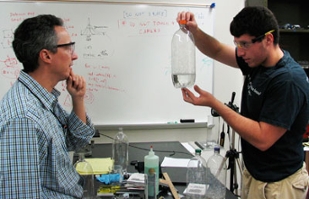Foam for Thought: There's Lots to be Learned From Those Suds
News
By Eric Gorton, JMU Public Affairs
|
Computer Models
Related Content: |
You probably see it every day. You create it whenever you use soap, it readily appears on top of carbonated beverages when they're poured or shaken and it forms on the beach as waves pound the shore.
Foam is so ubiquitous, it's really not worth much thought—or is it?
Dr. Klebert Feitosa, assistant professor of physics and astronomy, has found plenty of reasons to think about it, and in great detail. He's been studying foam for years and could talk about it for hours. He says he needs 36-hour days to do all the research he would like to do and he kids his astronomer colleagues that the whole universe is like a big foam.
"They all just leave," he says with a laugh.
But understanding the dynamics of foam has important implications in fields other than physics, including mathematics, biology and medicine. A topic of research for more than 200 years, scientists have discovered that the structure of foam closely resembles the structure of cells, cork, gels and many other things in nature. One of the leading foam studies was done in the 1940s by a botanist who found similarities in foam structure and the cells of plants he was studying.
"People are interested in the way that those bubbles pack together," Feitosa says. "How many faces do they form? And what is the average number of sides that each face has and what is the typical size of a bubble and how all that changes as the foam evolves and all of these kinds of questions."
In the 1800s, Belgian physicist Joseph Plateau observed that exactly three faces of soap bubbles in foam meet at angles of 120 degrees from each other to form an edge and exactly four edges come together at 109 degrees from each other to meet at a point. These universal laws became known as Plateau’s rules. When a bubble disappears, the remaining bubbles quickly rearrange to meet at those angles.
"What happens essentially is that the big bubbles have lower pressure so they’re eager to capture gas from the small ones," Feitosa explains. "So there is some sort of cannibalism going on inside the foam where the big ones keep on eating the small bubbles. During this process, the small one will shrink until a point where it completely disappears. And when that happens, the whole film structure has to readjust to a new configuration fairly quickly because the films don't like to be in any random configuration. It has to satisfy Plateau rules of energy minimization."
Among the projects Feitosa and his students are working on is creating computer-based 3-D wire-frame models of the structure of foam to investigate what happens inside of an evolving soap foam. The models are based on reconstructed images of real foam created by photographing the foam from different angles at different times and then stitching the photographs together in the same way medical images from CAT scans and MRIs are created. The models help quantify the vertices where the bubbles meet and to examine the shapes of bubbles as the foam evolves.
Studying foam dynamics could be especially helpful in researching other amorphous solids, things that are not quite solid and not quite liquid, says Anthony Chieco, a senior physics major who works in Feitosa's lab.
"Glass is the quintessential example where it flows at one point, it passes a certain temperature, it stops flowing. And the way they look at a molecular level is the same way that foams or grains look at a macroscopic level, so by studying these macroscopic structures you can understand the microscopic," says Chieco, who will be presenting the research in November at a meeting of the American Physical Society.
Feitosa is collaborating with Dr. Douglas Durian at the University of Pennsylvania, where he worked from 2004 to 2007, and hopes to expand his research to include the behavior of bubbles in small channels and in complex fluids. "One obvious application is medical, the medical use of bubbles as contrasting agents for ultrasound imaging," he said. Researchers also are looking at ways to use bubbles to carry drugs to targeted areas of the body.
Perhaps the day will come when Feitosa's research will reveal important information about the universe and he will be invited to talk to a captive audience of astronomers.



